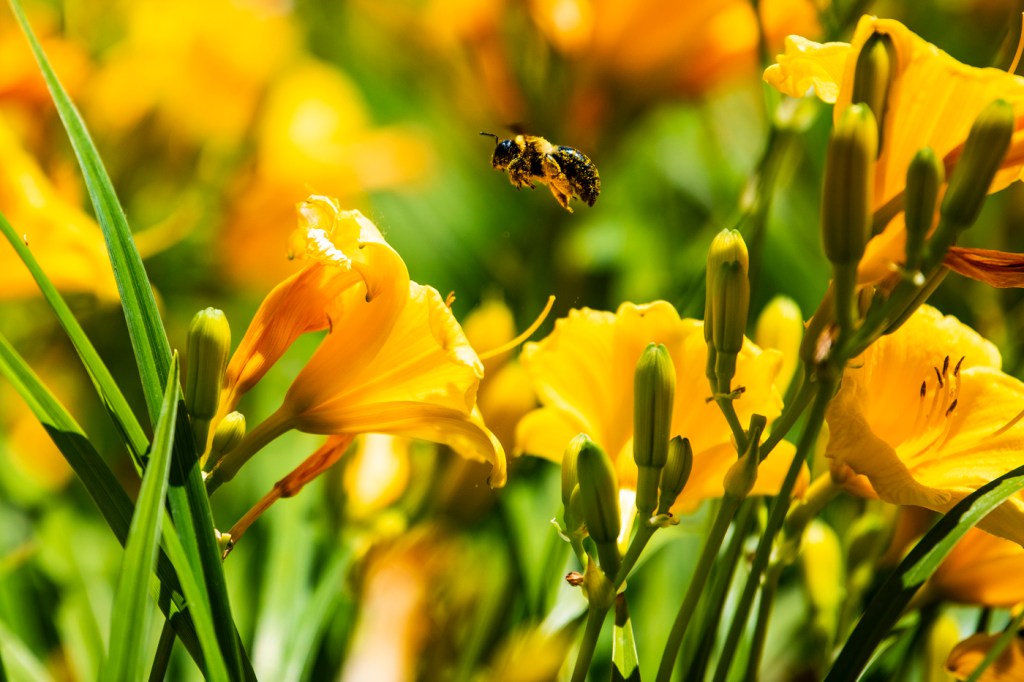Honeybees are key to biodiversity. Researchers say ecosystems collapsing because of climate change have bee-like species that can be reintroduced
Ecologists have been puzzling over how to determine the most important species to reintroduce into collapsing ecosystems. Northeastern researchers say the simplest answer is sometimes the best one.

There are very few animals as important to our world as honeybees. There is, of course, the delicious honey they produce, but they are also essential in maintaining food security and the biodiversity that is threatened by climate change and fast-becoming our strongest natural defense against it.
But with the planet facing a climate change-induced loss of biodiversity, what happens when honeybees die?
New Northeastern University research aims to help address the impending biodiversity crisis. The researchers say they have found a new strategy for restoring lost biodiversity by, essentially, identifying the equivalent of a honeybee in different ecosystems and reintroducing it into a particular collapsing ecosystem.
The term used by ecologists is keystone species, one that holds an ecosystem together.
“Our work essentially gives us an interesting way to bring network science together with dynamics to address the problem that many researchers have been highlighting regarding the extinction of species, reintroduction of species, how to identify keystone species, at what level we should be collecting that data and what to do if our ecosystems are data poor,” says Udit Bhatia, author on the paper who started this work at Northeastern before graduating in 2018 with a Ph.D. in civil and environmental engineering.
The team of researchers also includes Auroop Ganguly, professor of civil and environmental engineering at Northeastern and director of AI4CaS (AI for Climate and Sustainability) within Northeastern’s Institute for Experiential AI; Tarik Gouhier, associate professor of marine and environmental sciences at Northeastern; and Sarth Dubey, Bhatia’s colleague at the Indian Institute of Technology.
In ecology, the quest to find keystone species has been elusive, Ganguly says. Traditionally, ecologists have focused on more complex, “higher order topological” factors to help explain which species should be reintroduced to help recover biodiversity, according to Bhatia. There is, for example, what Bhatia calls “betweenness,” the idea that a keystone species is one that is most important to the flow of the network. It is “in between” the most species in an ecosystem’s network.

But the networked method they’ve developed says the simplest answer might actually be the best one.
“What our findings essentially suggest is that the ecologically most obvious answer –– the species which are most connected –– may be the ones that result in the fastest gain,” Bhatia says.
Featured Posts
For this paper, they analyzed 30 real-world plant-pollinator ecosystems around the world and also simulated 27 synthetic ecosystems with attributes that were not covered by the 30 real-world examples to find the best restoration strategy. Bhatia says they viewed each species of plant and pollinator in an ecosystem as an individual node in a broader network, with connections running between them.
To assess which strategies worked and which did not, they used three criteria: abundance, settling time and persistence. The ideal strategy is one when a species is reintroduced to its ecosystem, it increases abundance of that species while also taking less time to settle into and, hopefully, persist with the new dynamic created by the reintroduction of a species.
But with hundreds of species and thousands of connections running between all of them, it quickly becomes challenging to consider which is the best candidate to reintroduce to an ecosystem. On top of that, just looking at the connections might not be enough because each ecosystem has its own dynamic that can be disrupted by the reintroduction of a species.
“One level of understanding is how they’re connected, who relates to who, what is that mapping that gives a sense of topology and then how they simultaneously evolve,” Ganguly says. “It’s not one species evolving by itself; it’s each interaction with another [species].”
In order to wrangle all of those dynamics, they modeled the arc of each species’ growth rate –– varying degrees of growth, decline and decay. They then charted the impact that other species have on each other’s growth rate, whether they positively or negatively affect growth.
In the case of the plant-pollinator ecosystems they studied, the researchers ultimately came back to the honeybee. It’s what Ganguly calls a “generalist,” it pollinates many different species of plants and has the most connections in its network. It might sound like the most unsurprising answer, but Bhatia says it is important to bring the conversation back down to earth.
That doesn’t mean that reintroducing the most connected species to an ecosystem is the universal solution to restoring biodiversity loss. Ganguly cautions that even though their research has found a novel way of determining keystone species, each restoration strategy, including this one, comes with tradeoffs between abundance, stability and persistence.
However, the researchers are still excited to see how this new restoration strategy could give scientists the tool for finding the next honeybee that could help save our planet’s ecosystems.
“If we go to an ecosystem in volcanic regions of Japan, we may not have the honeybee there, but this approach will help us find an equivalent honeybee of that particular system that is holding that ecosystem together,” Bhatia says.










